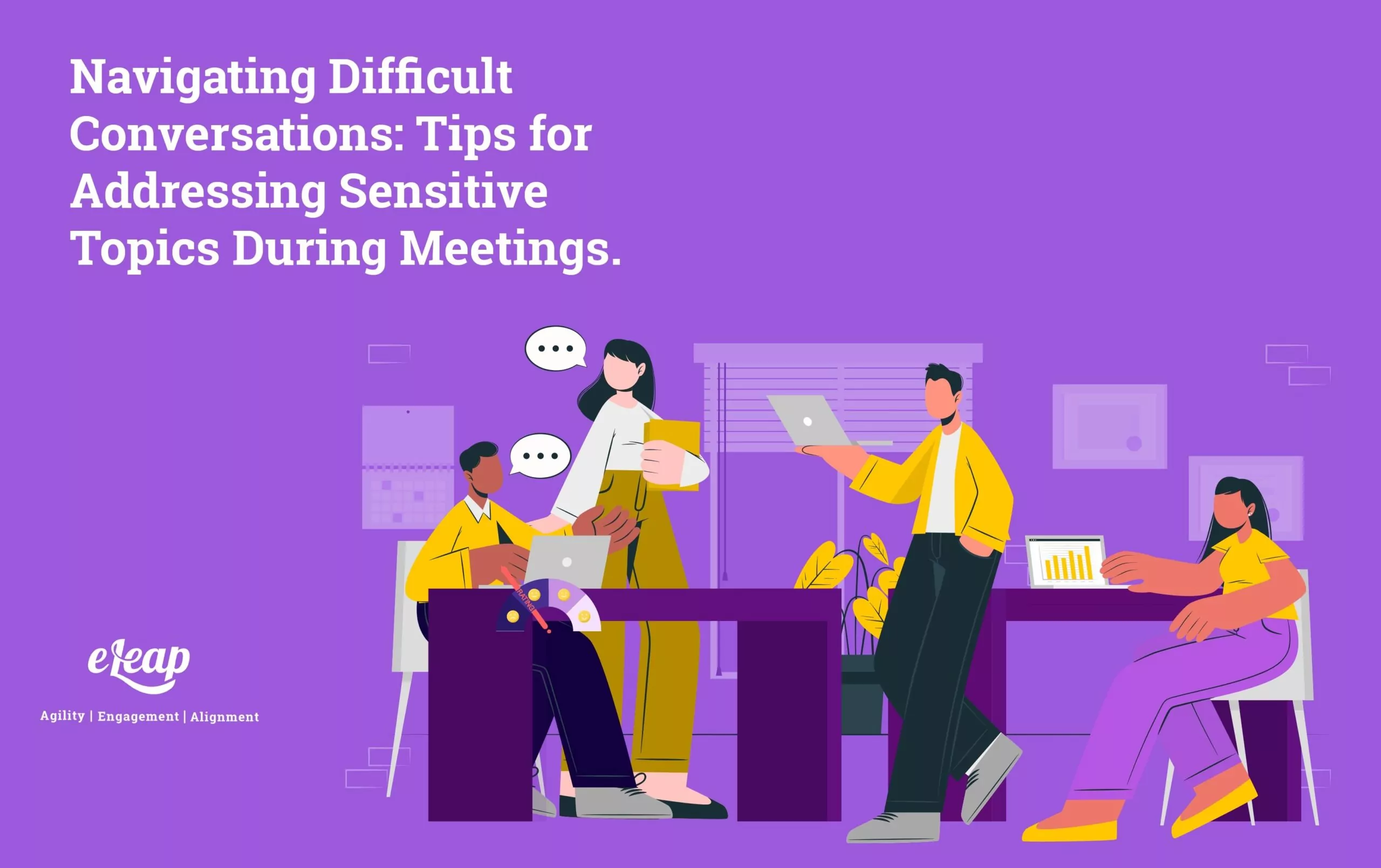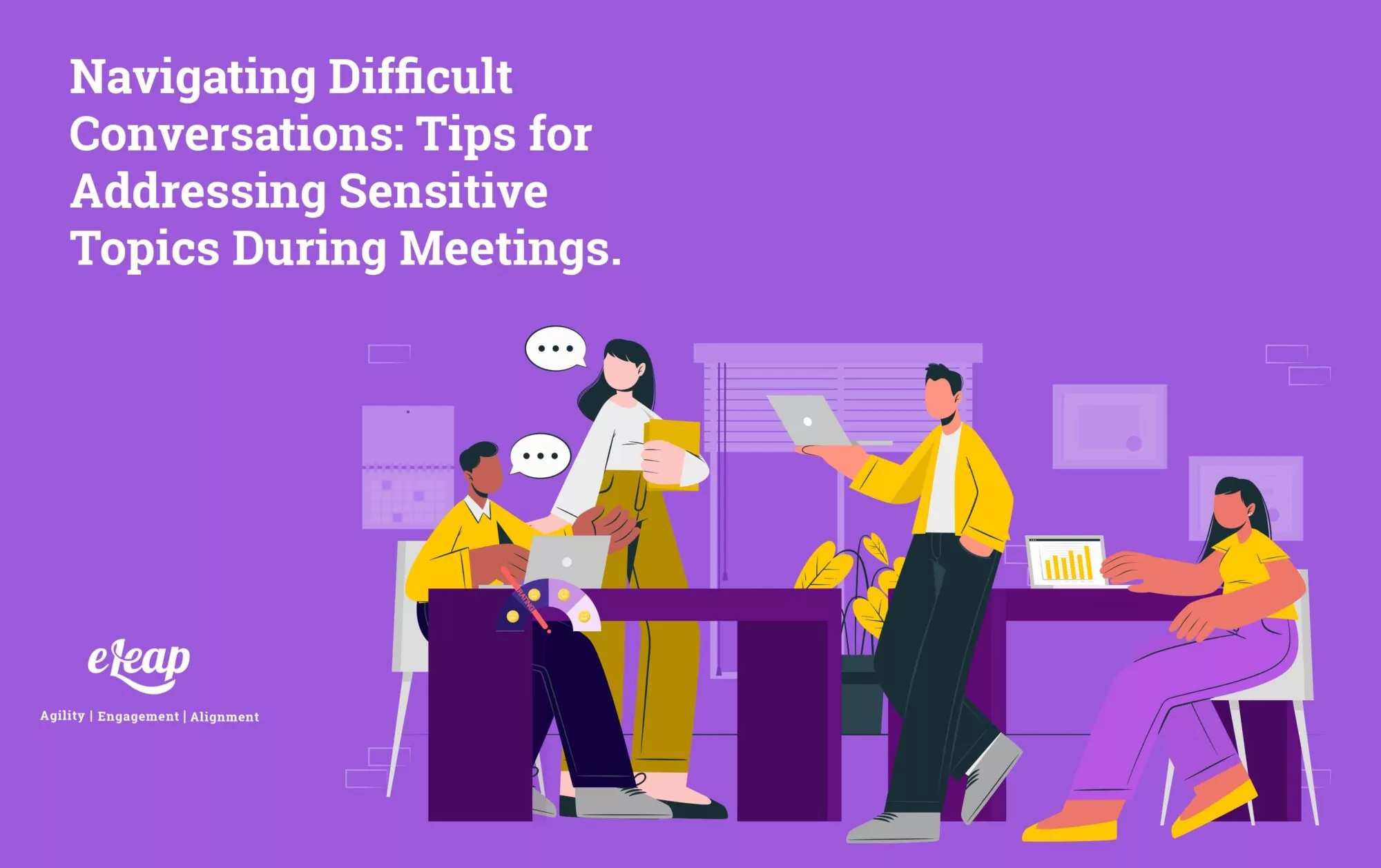Navigating Difficult Conversations: Tips for Addressing Sensitive Topics During Meetings

Leadership, at any level of an organization, often requires diving into the deep end of sensitive meetings topics. How sensitive topics are addressed in meetings can leave a lasting impression on your reputation and the company’s culture. The objective is clear: to steer these conversations toward a constructive and beneficial outcome, which necessitates a thoughtful and well-prepared approach. Explore how eLeaP®’s Performance Management Platform can simplify evaluations, boost productivity, and drive measurable results.

A study by the coaching and training firm Bravely (pdf) found a staggering 70% of employees tend to shy away from difficult workplace conversations. The reasons vary, from personal discomfort to apprehension about potential consequences, further compounded by previous negative experiences. Supporting this sentiment, a 2019 survey by VitalSmarts revealed that about 25% of individuals have been dodging a daunting conversation for at least half a year, while 37% admit they might leave their jobs to avoid these tough discussions. Such statistics speak volumes about the urgency and complexity of the issue at hand.
Against this backdrop, leaders must refine their conversational tactics. This isn’t merely a question of mitigating conflict but one of leveraging these moments to reinforce trust, drive performance, and shape a resilient organizational ethos.
As we venture into the nuances of this topic, we will dissect actionable strategies and garner insights from thought leaders, providing a structured approach to ensure that even the most sensitive conversations can be navigated successfully and with mutual respect.
Confronting the Uncomfortable: The Importance of Tackling Tough Topics Head-On Sensitive Meetings Topics
The following points explain why tackling challenging issues is crucial and how doing so effectively can positively impact your organization.
Trust and Transparency
- Building Trust: A Harvard Business Review article emphasizes that trust is the foundation of effective leadership and team dynamics. When leaders address sensitive issues directly, it demonstrates integrity and respect for team members, embracing trust.
- Creating Transparency: Addressing sensitive topics head-on during meetings can clarify misconceptions and promote transparency. This openness is linked to higher employee engagement and job satisfaction, according to a publication by Glassdoor.
Organizational Health
- Preventing Resentment: A report on workplace conflict statistics in 2023 found that 85% of employees deal with conflict on some level, and 29% do so “always or frequently.” Unaddressed sensitive topics can fester and lead to resentment, undermining team cohesion and productivity.
- Enhancing Communication: Regular, open communication about difficult subjects can prevent the buildup of workplace issues. Research from the Project Management Institute (PMI) shows that ineffective communications are a primary contributor to project failure 30% of the time.
Employee Well-Being
- Mitigating Stress: The workplace is a significant source of stress for many people. The American Institute of Stress notes that 80% of workers feel stress on the job, and nearly half say they need help learning how to manage stress. Addressing sensitive topics can help reduce the uncertainty and tension contributing to this stress.
- Promoting Mental Health: Leaders equipped to discuss sensitive issues compassionately contribute to a healthier work environment. According to a 2022 study, there is a clear link between the way stress is managed in the workplace and the mental health of employees.
Business Performance
- Improving Productivity: A Harvard Business Review publication reported that companies with high levels of openness and communication are more effective in performance outcomes. When leaders actively address sensitive issues during meetings, they prevent minor misunderstandings from escalating into significant roadblocks, directly enhancing team productivity and focus.
- Enhancing Problem-Solving: Teams confronting tough topics in meetings benefit from a more robust problem-solving process. This practice encourages a culture of open dialogue, leading to a more adaptive and innovative team.
Cultural Development
- Encouraging Innovative Thought: Open discussions during meetings about sensitive topics contribute to an environment where new ideas are welcomed and actively sought. This can lead to breakthrough innovations and solutions.
- Defining Communication Norms: By handling difficult conversations in meetings, leaders exemplify and reinforce a culture of transparency and empathy. This sets the tone for the entire organization, emphasizing the importance of a communicative and supportive work environment.
In summary, deliberate engagement with sensitive topics during meetings is essential for organizational vitality and prosperity. Thoughtful leaders who handle these discussions skillfully bolster trust and transparency, which in turn nurtures employee well-being, elevates team performance and molds the company culture. Consequently, refining the ability to navigate difficult conversations transcends a mere leadership competency, emerging as a strategic necessity for any thriving organization.
Strategies for Addressing Sensitive Topics During Meetings
Navigating sensitive discussions during meetings requires a strategic and mindful approach. Drawing from established communication frameworks and leadership models, here are key strategies to facilitate these crucial conversations effectively:
Prioritize Trust and Connection
In situations where sensitive topics can escalate into contentious issues, trust and emotional intelligence are critical for leadership. Here’s how leaders can leverage these elements strategically:
- Building a Foundation of Trust:
Trust is the cornerstone for any meaningful conversation, particularly when it comes to sensitive subjects. Leaders should strive to create an environment of trust long before challenging topics arise. This involves demonstrating consistent, reliable behavior, transparency in decision-making, and a track record of following through on commitments. This established trust will encourage employees to engage more openly and honestly during challenging conversations, reducing the potential for defensiveness or conflict.
- Exercising Emotional Intelligence:
The role of emotional intelligence in leadership cannot be overstated, especially during sensitive discussions. Leaders should be adept at reading the room, recognizing the emotional undercurrents, and responding empathetically. They must be able to express understanding and compassion while guiding the conversation with a steady hand. Leaders who successfully combine emotional insight with decisive action can navigate tough topics more effectively, ensuring their team feels heard and valued, even when the message is difficult to deliver. A systematic literature review of 29 studies on emotional intelligence (EI) further reinforces this. It demonstrates that EI can significantly aid in managing and resolving conflicts. The review suggests that understanding and employing emotional intelligence can be pivotal in conflict management within the workplace.
These strategies help ensure that when the time comes to address challenging subjects, the groundwork of trust and emotional intelligence has set the stage for a productive dialogue. By integrating these approaches into your leadership style, you can transform potential conflicts into opportunities for organizational growth and strengthened relationships.
Dissect the Layers of Conversation
Navigating sensitive discussions during meetings requires a thoughtful deconstruction of the dialogue’s multiple layers to ensure a meaningful and productive conversation.
- Emotional Resonance:
Sensitive topics often stir strong emotions, quickly escalating tensions if not handled with care. As a leader, it’s your role to create a space where feelings can be expressed without fear of judgment. This doesn’t mean dwelling on the emotions but acknowledging them as a legitimate part of the conversation. By doing so, you validate the feelings of all participants, which can reduce defensiveness and promote a clearer, more focused dialogue on the issues at hand.
- Identity Considerations:
Each person enters a conversation with their sense of self, which includes their values, experiences, and professional identity. Recognize that sensitive topics might challenge or threaten these identities. An awareness of this layer means you can navigate the conversation with a more profound sense of empathy. Understand that it’s not just about resolving a situation; it’s also about preserving dignity and respect for all involved. When people feel their identities are acknowledged and not under attack, they are more likely to engage constructively and openly, leading to more fruitful discussions and outcomes.
- Tactful Assertiveness:
As a leader, you must strike a delicate balance between being open to diverse viewpoints and providing decisive guidance. Recognize and validate the various perspectives offered, reflecting an inclusive approach. Yet, it is your role to distill these insights into a coherent path forward. After considering all angles, deliver your verdict with clear reasoning and empathy. Your assertiveness, paired with tact, should not dictate but rather direct the team toward unified, strategic action.
Engage in Active Listening
Engaging in active listening when addressing sensitive topics during meetings means fully concentrating on the speaker, understanding their message, responding thoughtfully, and remembering the discussion points. It involves listening to both parties and picking up the nuances and emotions behind their points.
- Empathetic Engagement:
This is about giving the speaker your undivided attention and being genuinely interested in their perspective. It involves being open and curious rather than defensive or preoccupied with your response. An empathetic stance helps you to understand the root causes of issues, not just the surface-level symptoms, and this understanding is essential for resolving sensitive matters effectively.
- Summarize and Clarify:
By restating critical points of what the speaker has said, you not only show that you are engaged in the conversation but also that you care about getting it right. This practice can prevent miscommunications and ensure all parties are on the same page. Summarizing what has been communicated allows the speaker to correct misinterpretations, leading to a clearer, more open dialogue.
Communicate with Precision
In addressing sensitive topics during meetings, precision in communication is paramount, ensuring that discussions are based on facts and specific instances, which aids in clear understanding. This approach helps keep the conversation on track and avoids a derailment into emotionally charged exchanges.
- Specifics Over Generalizations:
Clarity is vital when addressing complex issues. By citing specific incidents and using concrete data, you can steer the conversation away from abstract accusations and towards a productive dialogue. This specificity also helps the other party understand exactly what behavior or event is under discussion, allowing them to respond precisely.
- Recency Effect:
Discussing recent examples ensures that the feedback is timely and top-of-mind. This relevance is especially crucial during performance reviews or feedback sessions, where discussing an issue that occurred too far in the past may seem irrelevant or may have been influenced by the “fading effect” bias, where the intensity of emotions associated with the memory diminishes over time.
Apply Reflective Leadership
Leadership demands introspection and wise judgment, particularly when navigating complex issues. The Reflective Leadership Model offers a structure for leaders to guide their teams effectively through challenging discussions:
- Continuous Self-Reflection:
Regular self-reflection is critical. Leaders should continually assess and reassess their actions and decisions in light of their responsibilities. This habit ensures that when sensitive topics arise, leaders are already attuned to the nuances of the situation and can navigate the conversation with a clear understanding of their own cognitive and ethical frameworks.
- Informed Actions:
In the throes of difficult dialogue, it’s critical to have previously engaged in self-reflection to anticipate your emotional responses and recognize any inherent biases that could skew your perspective. Informed actions spring from a well of self-awareness, allowing leaders to sidestep potential pitfalls and lead the conversation toward constructive outcomes. Before entering a conversation about sensitive issues, leaders should arm themselves with this reflective insight, ensuring that their contributions to the discussion are measured, empathetic, and aligned with their ethical compass. This foresight not only tempers the immediate emotional response but also shapes the strategic direction of the conversation, ensuring that decisions and actions taken consider all viewpoints and the broader implications for the team and organization.
Collaborative Problem-Solving

Collaborative problem-solving is central to effective leadership, turning potential conflicts into collective triumphs. Here’s how leaders can engage their teams in constructive dialogue when addressing sensitive topics during meetings:
- Joint Brainstorming:
Embarking on problem-solving as a collaborative venture transforms challenges into opportunities for collective creativity. By valuing each team member’s input equally, leaders provide a fertile ground for innovative ideas and encourage a culture where every voice can contribute to the solution.
- Shared Resolution:
The power of a resolution lies in the collective commitment of those who will enact it. By involving employees in the formulation of action steps, leaders not only empower their teams but also ensure a more profound dedication to the resulting decisions. This approach often yields more effective solutions and solidifies a partnership ethos within the team.
Effective Language Strategies to Navigate Sensitive Topics During Meetings
Effective communication is the linchpin of any successful meeting, especially when dealing with sensitive issues. The words chosen can either bridge gaps or create barriers, significantly influencing the meeting’s outcome and the emotional well-being of those involved. Effective language strategies are thus essential for leaders who aim to navigate these delicate conversations with care and constructiveness.
Words and Expressions to Avoid
Here are words and expressions that are best avoided, along with their psychological effects during sensitive discussions in meetings:
- Accusatory Language: Words like “you always” or “you never” can trigger defensive reactions as they generalize behavior and criticize the person instead of addressing the specific issue. This can lead to a psychological phenomenon known as the fundamental attribution error, where individuals attribute others’ actions to their character rather than situational factors, potentially escalating conflict.
- Absolutes: Using absolutes such as “must,” “can’t,” or “impossible” can close off dialogue and create a feeling of entrapment or hopelessness. Psychologically, this diminishes the perceived autonomy of employees, leading to resistance or disengagement.
- Negative Labels: Terms that label people, such as “lazy” or “incompetent,” can impact self-esteem and ignite a threat response in the brain. This not only hampers the individual’s ability to listen and engage constructively but can also have long-term effects on their self-image and job performance.
- Sarcasm and Mockery: While sometimes used to lighten the mood, these can be misinterpreted as belittlement, leading to feelings of resentment and undermining trust.
- “But” in Responses: When someone says “I understand, but…,” it often negates everything before it, suggesting that the speaker’s understanding is superficial. This can invalidate the employee’s experience, leading to frustration and a lack of trust in the speaker’s empathy.
The aim should be to use specific, constructive language that focuses on the behavior or situation rather than the individual. This approach helps to keep the conversation objective, reduces emotional intensity, and promotes a more rational and problem-solving-oriented discussion.
Words and Expressions to Embrace
Here are some words and expressions that can be effective:
- Inclusive Language: Phrases like “we” or “us” emphasize teamwork and shared goals, which can psychologically reinforce a collective identity and shared responsibility, making it easier to tackle challenging issues cooperatively.
- I-Statements: Using “I feel” or “I think” instead of “you” statements can help in expressing one’s views without assigning blame. This approach reduces defensiveness in others by focusing on personal reactions rather than accusations.
- Open-Ended Questions: Questions such as “How do you see the situation?” invite participation and signal that you value the other person’s perspective. This can increase feelings of psychological safety and encourage honest, productive exchanges.
- Positive Reinforcement: Expressions of appreciation and acknowledgment, like “I value your effort” or “Thank you for your work,” validate contributions and can increase motivation and morale, building a more positive atmosphere.
- Flexible Language: Words like “could,” “might,” and “possibly” introduce flexibility and openness to ideas. This can inspire a problem-solving mindset, reducing the pressure of commitment that often accompanies more definite terms.
- Words That Acknowledge Effort and Progress: Phrases such as “I’ve noticed the progress in…” or “Your work on… has really improved” recognize effort, which can boost confidence and reinforce a growth mindset among team members.
By consciously employing language that builds trust, respects individual contributions, and fosters collaboration, leaders can create a space where even the most sensitive topics can be discussed constructively.
Conclusion
The capacity to address sensitive issues in meetings is a definitive element of leadership, essential for nurturing a culture of openness and driving organizational advancement. By deliberately applying the strategies explored in this article—embracing trust, practicing emotional intelligence, active listening, and engaging in reflective leadership—managers and leaders can elevate these critical conversations into opportunities for growth and understanding.
When sensitive topics are approached with clarity, empathy, and a collaborative spirit, the outcomes extend beyond the meeting room, impacting employee well-being, productivity, and the company’s innovative potential. As we have seen, the challenges of addressing tough topics head-on are matched by the profound benefits: a more engaged workforce, a transparent environment of mutual respect, and a resilience that allows individuals and organizations to thrive amidst adversity. Leaders adept at these strategies do not simply resolve immediate concerns; they lay the groundwork for a robust, communicative, and innovative workplace environment.
Elevating Organizational Growth with eLeaP
Since its inception in 2002, eLeaP has steadfastly committed to transforming workplaces. Through our robust Learning Management System (LMS) and Performance Management Platform (PMP), we create dynamic environments that encourage enhanced engagement, performance, and skill development.
eLeaP’s prestige is highlighted by awards like the Capterra Award and eLearning Industry’s Top 10 LMS Website Designs Award, underscoring our unwavering dedication to creating exceptional learning and growth experiences. The Check-ins, 1-on-1s, and Recurring Meetings System are particularly relevant when navigating difficult conversations. This innovative PMP module empowers leaders and teams to structure their interactions more effectively with customizable agendas that provide a clear framework for addressing sensitive topics. Its integration with mainstream calendars like Google and Outlook Calendars also ensures that these crucial touchpoints are conducted with the consistency and preparation necessary to embrace an environment of open dialogue and continuous improvement.